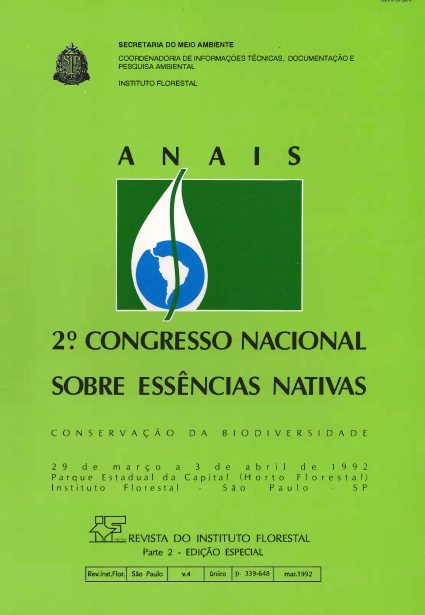CONSÓRCIO DE ESPÉCIES NATIVAS DE DIFERENTES GRUPOS SUCESSIONAIS EM TEODORO SAMPAIO-SP
DOI:
https://doi.org/10.24278/2178-5031.199242829Keywords:
Mixed plantations, indigenous species, seconqary successionAbstract
The results of trials with consortium of species from different ecological groups, based on secondary succession, at 2 years of age in Teodoro Sampaio (Usina Hidreletrica de Rosana-CESP), are presented. The trial was established with the combination of 5 native tree species of the area, representative of 4 successional groups (BUDOWSKI, 1965); the total number of treatments was 23, with 1000m2 plots on 4 replications (total area of 9.2ha), and a randomized block designo The obtained results at 2 years of age show significant variation among treatments for the major part of the 6 traits and 5 species studied. The species which showed significant variation among treatments for the larger number of traits was the climax followed by the early secondary and the late secondary species.The pioneer species did not present variation among treatments. The results show that the separation of species based on secondary suecession is an important tool for establishing mixed forests with native tree species.
Downloads
References
BAZZAZ, F. A e PICKETT, S. T. A, 1980. Physiological ecology of tropical succession: a comparative review. Annuel reviewofecology and Systematics. 11 :287 -310.
BUDOWSKI, G. 1965. Distribution of tropical american rain forest species in the light of successional progresso Turrialba, 15: 40-42.
DENSLOW, J. S., 1980. Gap partioning among tropical forest trees. Biotropica. 12:47-55.
GÓMEZ-POMPA, A 1971. Possible papel de Ia vegetación secundária en Ia evolución de Ia flora tropical. Biotropica, Lawrence, 3:125-35.
HARTSHORN, G. S., 1978. Tree falls and tropical forest dynamics.ln: P.B.Tomlinson and M.H.Zimmerman (eds.) Tropical Treesasliving systems. Cambridge, Cambridge University Press, 1978. p.535-60.
KAGEYAMA, P. Y.; BRITO, M. A & BAPTISTON, I. C., 1986. Estudo do mecanismo de reprodução de espécies da mata natural. In: KAGEYAMA, P.Y. (coord.). Estudo para implantação de matas ciliares de proteção na bacia hidrográfica do Passa Cinco, visando a utilização para abastecimento público. Piracicaba. DAEE/USP/FEALQ. 285 p. (Relatório de Pesquisa).
KAGEYAMA, P. Y.; BIELLA, L. C. e PALERMO JR., A, 1990. Plantações mistas com espécies nativas com fins de proteção a reservatórios. In: 6Q Congresso Florestal Brasileiro. Florestas e Meio Ambiente: Conservação e produção, patrimonio social. 22 a 27 de setembro de 1990. Campos do Jordão-SP. Vol.1. p.1 09-113.
KAGEYAMA, P. Y. & CASTRO, C. F. A, 1989. Sucessão secundária, estrutura e plantações de espécies arbóreas nativas. IPEF. Piracicaba, 41/42:83-93.
KAGEYAMA, P. Y.; CASTRO, C. A. F. & CARPANEZZI, A. A, 1989. Implantação de matas ciliares: estratégias para auxiliar a sucessão secundária. In: BARBOSA, L.M. (Coord.). Simpósio sobre mata ciliar. Anais. Fund. CARGIL. p.130-143.
OLDEMAN, R. A A, 1978. Architecture and energy exchange of dycotiledoneous trees in the forest. In: TOMLlNSON, R.B. & ZIMMERMANN, M.H. Tropical trees as living systems. Cambridge, Cambridge University Press. p.535-60.
ORIANS, G. H., 1982. The influence of tree-falls in tropical forests in tree species richness. Tropical eco/ogy, 23:255-78.
WHITMORE, T. C., 1982. On pattem and process in forests. In: NEWMAN, C.I. The plant community as a working mechanism. Oxford, Blackwell, p.45-59.















